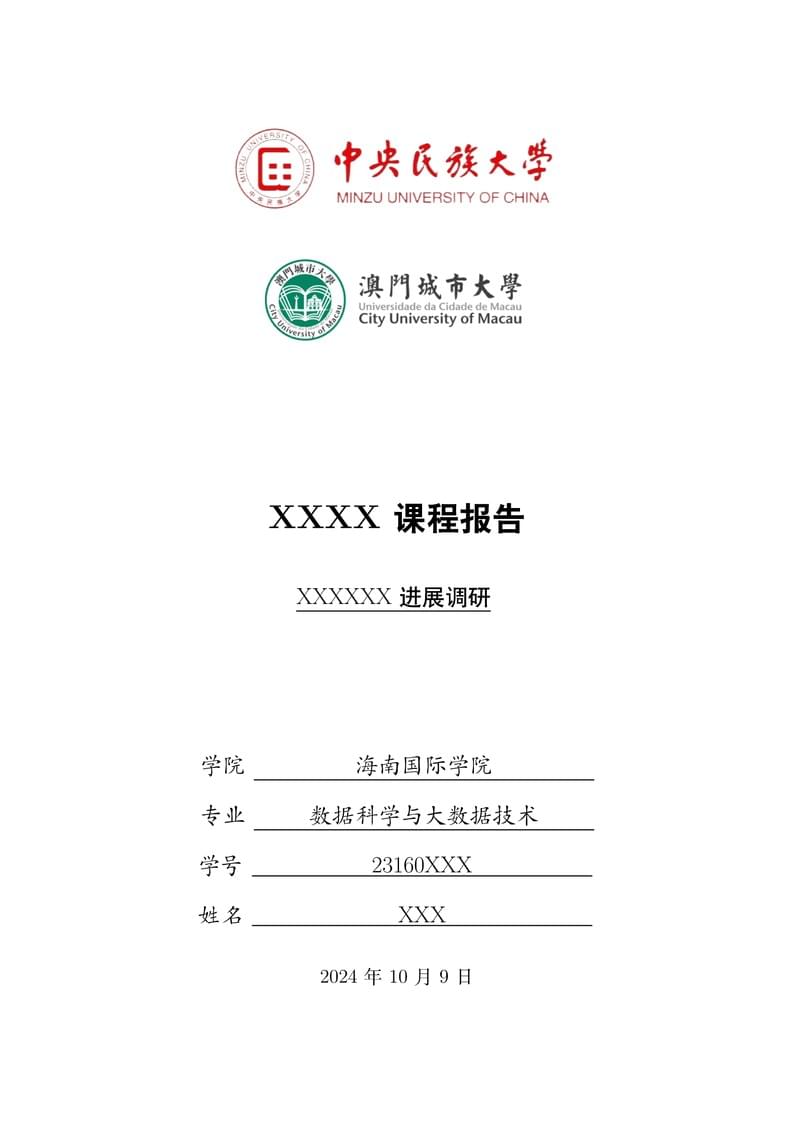
这个模板来自并服务于中央民族大学和澳门城市大学合作办学的海南国际学院的学生。由于我们的两个(很好的)学校没有官方的模版,也没有前者写过这样的模版,我自己整合别的学校的课程报告模版和自己的排版经验,写了一个简单的模版。更多信息请联系zeroandyue@gmail.com

%!TeX program = xelatex
\documentclass[12pt,hyperref,a4paper,UTF8]{ctexart}
\usepackage{MUCReport}
%%-----------------正文开始------------------%%
\begin{document}
%%-------------------封面--------------------%%
\cover
%%------------------摘要---------------------%%
%\begin{abstract}
%
%在此填写摘要内容
%
%\end{abstract}
\thispagestyle{empty} % 首页不显示页码
%%--------------------------目录页------------------------%%
\newpage
\tableofcontents
\thispagestyle{empty} % 目录不显示页码
%%------------------------正文页从这里开始-------------------%
\newpage
\setcounter{page}{1} % 让页码从正文开始编号
%%可选择这里也放一个标题
%\begin{center}
% \title{ \Huge \textbf{{标题}}}
%\end{center}
\section{模板说明}
本模板主要适用于一些课程的平时论文以及期末论文,默认页边距为2.5cm,中文宋体,英文Times New Roman,字号为12pt(小四)。
编译方式:\verb|xelatex -> bibtex -> xelatex*2|
默认模板文件由以下四部分组成:
\begin{itemize}
\item \texttt{main.tex} 主文件
\item \texttt{reference.bib} 参考文献,使用bibtex
\item \texttt{MUCReport.sty} 文档格式控制,包括一些基础的设置,如页眉、标题、学院、学号、姓名等
\item \texttt{figures} 放置图片的文件夹
\end{itemize}
第一次使用时需前往\texttt{MUCReportReport.sty} 对标题、姓名、学号、页眉等进行设置,设置完后即可一劳永逸,封面LOGO亦可替换。
默认带有封面页以及目录页,页码从目录页开始。
\section{一些插入功能}
\subsection{插入公式}
行内公式$v-\varepsilon+\phi=2$。
插入行间公式如\autoref{Euler}:
\begin{equation}
v-\varepsilon+\phi=2
\label{Euler}
\end{equation}
\subsection{插入图片}
MUC校徽如\autoref{MUC}所示,注意这里使用了\verb|~\autoref{}|命令,也就是会自动生成“图”“式”等前缀,无需手动输入。
\begin{figure}[!htbp]
\centering
\includegraphics[width =.5\textwidth]{figures/muc.png}
\caption{中央民族大专}
\label{MUC}
\end{figure}
\begin{figure}[htbp]
\centering
\subcaptionbox{澳门城市大学\label{fig:11}}%
{\includegraphics[width=0.48\textwidth]{figures/CityU.png}}\hfill
\subcaptionbox{中央民族大学软科103\label{fig:22}}%
{\includegraphics[width=0.48\textwidth]{figures/muc.png}}
\caption{很好的两所学校:)}
\label{fig:ds1}
\end{figure}
这是两张图片联排的样式。
\begin{wrapfigure}{r}{0.5\textwidth}%靠文字内容的右侧
\centering
\includegraphics[width=0.45\textwidth]{figures/CityU.png}
\caption{这个是文字环绕式排版} \label{fig1}
\end{wrapfigure}
文字环绕式的图片一定要放在想插入的段落的前面,否则Latex就会自作主张发疯。
插入上面图片的代码:
\begin{verbatim}
\begin{figure}[!htbp]
\centering
\includegraphics[width =.5\textwidth]{}
\caption{中央民族大专}
\label{RUC}
\end{figure}
\end{verbatim}
\subsection{插入文本框}
本模板定义了一个圆角灰底的文本框,使用简化命令\verb|\tbox{}|即可,如果你不喜欢,可以前往 \texttt{MUCReport.sty}对其进行修改。
\tbox{
这是一个圆角灰底的文本框
}
\subsection{插入表格}
本模板文件如表~\ref{doc} 所示。
\begin{table}[!htbp]
\caption{本模板文件组成}
\centering
\begin{tabular}{l | l}
\hline
文件名 & 说明 \\
\hline
\texttt{main.tex} & 主文件 \\
\texttt{reference.bib} & 参考文献 \\
\texttt{MUCReport.sty} & 文档格式控制\\
\texttt{figures} & 图片文件夹 \\
\hline
\end{tabular}
\label{doc}
\end{table}
\begin{table*}[!ht]
\caption{三线表}\label{tab:三线表}
\centering
\begin{tabularx}{\textwidth}{@{}lXXXX@{}} % First column left-aligned, others flexible
\toprule
Model & Recall & Precision & F1 score & Accuracy \\
\midrule
321 & 0.1 & 0.1 & 0.1 & 0.1 \\
123 & 0.1 & 0.1 & 0.1 & 0.1 \\
321 & 0.1 & 0.1 & 0.1 & 0.1 \\
123 & 0.1 & 0.1 & 0.1 & 0.1 \\
\bottomrule
\end{tabularx}
\end{table*}
%\section{定理环境}
%\begin{Theorem}
%\end{Theorem}
%
%\begin{Lemma}
%\end{Lemma}
%
%\begin{Corollary}
%\end{Corollary}
%
%\begin{Proposition}
%\end{Proposition}
%
%\begin{Definition}
%\end{Definition}
%
%\begin{Example}
%\end{Example}
%
%\begin{proof}
%\end{proof}
\subsection{插入高亮代码块}
\textbf{MATLAB source code:}
\lstinputlisting[language=Matlab]{./code/matlab.m}
\textbf{Python source code:}
\lstinputlisting[language=Python]{./code/python.py}
%\textbf{Pseudocode:} %伪代码
%\lstinputlisting[language=C]{./code/Pseudocode.cpp}
利用\verb|lstlisting| 配置
\begin{lstlisting}[style=CPP, title="c++代码"]
#include <iostream>
#include <array>
int main()
{
constexpr int MAX = 100;
std::array<int, MAX> arr;
}
\end{lstlisting}
\begin{lstlisting}[style=Java, title="Java代码"]
public void addAdvertisement(String company, String ad_Category, String ad_Type, String ad_Price)
{
int price = Integer.parseInt(ad_Price);
ad = new Advertisement(company, ad_Category, ad_Type, price);
adList.add(index, ad);
index++;
anDM = getDefaultDirectoryManager();
ActorTuple tuple = new ActorTuple(getActorName(), "advertiser",
company, ad_Category, ad_Type, price, index-1);
send(anDM, "register", tuple);
}
\end{lstlisting}
\begin{lstlisting}[style=Python, title="Python代码"]
import random
import collections
Card = collections.namedtuple('Card', ['rank', 'suit'])
class FrenchDesk:
ranks = [str(n) for n in range(2, 11)] + list('JQKA')
suits = 'spades diamonds clubs hearts'.split()
def __init__(self):
self._cards = [Card(rank, suit) for rank in self.ranks for suit in self.suits]
def __len__(self):
return len(self._cards)
def __getitem__(self, position):
return self._cards[position]
desk = FrenchDesk()
\end{lstlisting}
\subsection{插入参考文献}
直接使用\verb|\cite{}|即可。
例如:
\textit{ 此处引用了文献\cite{0Isaac}。此处引用了文献\cite{2016The}}
引用过的文献会自动出现在参考文献中。
\section{写在最后}
\subsection{发布地址}
\begin{itemize}
\item Github: \url{https://github.com/Zhangxy373/MUC-CityU_Report_Latex_Template}
\item Overleaf: \url{https://www.overleaf.com/latex/templates/muc-plus-cityuke-cheng-bao-gao-mo-ban/xcmjmkmcxmny}
\end{itemize}
%%----------- 参考文献 -------------------%%
%在reference.bib文件中填写参考文献,此处自动生成
\reference
\end{document}